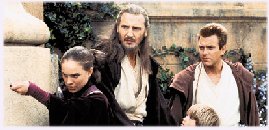
Episode I: The Phantom Menace
Character Names: Queen Amidala & Padmé Naberrie
 Go back
Go back
|
Reviews
From James Berardinelli's Film Reviews
Episode I - 3.5 out of 4 stars
United States, 1999
Cast: Liam Neeson, Ewan McGregor, Natalie Portman, Jake Lloyd,
When George Lucas first conceived the idea for Star Wars, it was just a movie. Over the course of
22 years, it has grown into a full-blown phenomenon - an event that gives promoters orgasmic
shivers and makes theater employees wish they could take a week off. When it comes to unbridled
anticipation generated by the release of a film, The Phantom Menace has antecedents. Gone with
the Wind was the entertainment event of the '30s. Goldfinger was so popular that some movie
houses stayed open 24 hours a day to meet demand. And Star Trek: The Motion Picture had
Trekkies and Trekkers standing in lines for hours on end. Yet, in terms of both intensity and
widespread interest, the motion picture industry has never seen anything like this before, nor is it
likely to in the foreseeable future (not even in 3 years, when the next Star Wars movie is released).
The hype has dwarfed the film, reducing it to a cultural footnote. Even Lucas, who will reap the
majority of The Phantom Menace's financial windfall, is concerned. In New York on May 9, he
was quoted as saying, "People should have a well-rounded life. I'm happy that Star Wars stimulates
young people's imagination... but when you get a situation like this where you have so much hype and
expectation, a movie can't possibly live up to that."
Indeed, when you get right down to it, The Phantom Menace is a movie, and can be treated as
such. Those who have camped out at a theater box office for three-plus weeks may disagree, as may
those who have spent $500 on an advance charity screening, but, in the end, everyone will be doing
the same thing, regardless of whether they're the first admission or the last: sitting in a darkened
theater, staring at the screen, and absorbing the sounds and images that represents the vision of a film
maker who has left an indelible imprint upon two generations of movie-goers. Consideration of the
movie, with its strengths and weaknesses, deserves to be divorced from an analysis of the Star Wars
phenomenon. This is not the greatest film ever made, as some fans would have you believe, nor does
it signal the death knell of artistic motion pictures, as high-brow critic-prophets cry out.
So what about the movie? How close does it come to meeting the astronomical expectations placed
upon it by a frenzied fandom and a curious public? The best place to start is with the storyline, which
does an effective job of fulfilling its three-fold purpose: telling a self-contained tale set in the Star
Wars universe, setting up the first trilogy, and remaining faithful to the previously-established mythos.
We already know how everything ends. Now it's time to learn how it all begins. The Phantom
Menace starts in familiar fashion: the Lucasfilm logo materializes, followed by the words "Star Wars",
then the introductory crawl - all are done in accompaniment to John Williams' score. It's the kind of
opening that brings a twinge of nostalgia to those of us who were there, in theaters, in 1977.
Jedi Master Qui-Gon Jinn (Liam Neeson) and his apprentice, Obi-Wan Kenobi (Ewan McGregor,
keeping his clothes on throughout), are on a diplomatic mission to the planet Naboo, where they
hope to negotiate the end to a blockade of the planet organized by the Trade Federation. When they
arrive, however, they find themselves caught in a trap sprung by the mysterious Darth Sidious (Ian
McDiarmid), who is making a play to take control of the Galactic Republic. After surviving an
attempt on their lives in a planet-orbiting space station, Qui-Gon and Obi-Wan end up on the ground
in the midst of an invasion by an army of droids. After meeting the amphibious Jar Jar Binks (Ahmed
Best), they move to save Naboo's teenage ruler, Queen Amidala, from possible execution. That
involves taking her and her retinue (including her favorite squat droid, R2-D2) into space. From
Naboo, the action moves to the desert planet of Tatooine, where the two Jedi encounter young
Anakin Skywalker (Jake Lloyd), a slave child with amazing potential in the Force, then to the capital
world of the Republic, and finally back to Naboo. Meanwhile, Darth Maul (Ray Park), Sidious'
minion, is tracking the Jedi with dire intentions.
Even though this film takes place some forty years before Star Wars, there are plenty of familiar
faces. In addition to R2-D2 (again played by Kenny Baker), an "unfinished" C-3PO (voice provided
by Anthony Daniels) is around for a segment of the story. Jabba the Hut has a brief cameo, and
Yoda is in a couple of scenes. There's also Senator Palpatine/Darth Sidious, who will eventually
become Return of the Jedi's Emperor Palpatine. And new actors are on hand to play the familiar
parts of Obi-Wan Kenobi (Alec Guinness in the original) and Anakin Skywalker.
Plot-wise, the film borrows a lot, at least in terms of structure, from Return of the Jedi. After a
rousing opening sequence, things slow down for a while. Then, on Tatooine, there's an amazing
racing sequence featuring "pod" space ships. Finally, the film concludes with three separate,
simultaneous story threads all building to a climax. The martial arts-influenced light saber duel
between Darth Maul and Qui-Gon & Obi-Wan is the best that The Phantom Menace has to offer -
a virtuoso action sequence directed with skill and understanding of what an audience craves from this
sort of confrontation. Those looking for influences will find that Lucas draws from sources as diverse
as TV sports commentary and religious traditions (there's a "Chosen One" - not Keanu Reeves - and
a virgin birth). Attempts to provide a more scientific explanation for the Force are ineffective,
however. Ben Kenobi's quick tutorial in the original Star Wars should have been allowed to stand on
its own. Adding physics to the metaphysical doesn't work.
The Star Wars movies have always relied on the nobility of heroes and the nastiness of villains, and
The Phantom Menace is no exception. As Qui-Gon, Liam Neeson brings an unforced nobility to his
performance, while Ewan McGregor injects a sense of recklessness into his portrayal of Obi-Wan.
Neither is an earthshaking acting job, but the two accomplished thespians are doing more than simply
reacting to special effects. On the other side of the Force is Ray Park's Darth Maul (he of the
black-and-orange painted face), who doesn't say much, but compensates with menacing stares and
quick reflexes. Ian McDiarmid makes for a more chilling villain, even though his Darth Sidious stays
in the shadows.
The other characters are a mixed bag. Jake Lloyd's performance as Anakin has been criticized in
some circles, but that seems a little unfair. He's enthusiastic, but not polished, and, while there are
scenes in which he strikes the wrong note, there are also instances when he's good. Natalie Portman,
easily one of today's best young actresses, isn't given much to work with; she's too often in the
background (although a couple of her scenes with Lloyd are effective at suggesting a deepening
bond). The best performance belongs to Swedish actress Pernilla August (The Best Intentions,
Fanny & Alexander), who gives a quiet, dignified portrayal as Anakin's mother. Ahmed Best plays
Jar Jar Binks, a computer generated mistake included primarily for comic relief. He will amuse
children but annoy adults. Finally, well-respected actors Terrence Stamp and Samuel L. Jackson
have welcome cameos.
Plainly, this is not an actors' movie and the director, George Lucas (at the helm for the first time since
the original Star Wars), is not an actors' director. Lucas' forte is in creating worlds and pushing the
special effects envelope, and, in both of those areas, The Phantom Menace doesn't just meet
expectations - it exceeds them. For the most part, Lucas' vision isn't limited to putting spectacular
visuals on screen for the purpose of creating a momentary sense of awe. His intention is to craft a
wonderful, weird, vast universe that we can experience in a way that no other movie has been able to
offer.
The Phantom Menace is a testimony to how far special effects have come. Does Lucas overdo it?
Yes. Every scene is crammed with as many aliens, otherworldly creatures, and CGI synthetics as
space will allow. Sometimes, it's breathtaking, but there are occasions when Lucas seems to be
saying, "See! Look what I can do!" Another problem with the aliens is that some of them are too silly
to be convincing, as if the director was placing added emphasis on capturing the adulation of the
under-10 audience (something he probably already has). Jar Jar Binks is the most glaring example.
He's irritating, and obviously a special effect.
It's in set design that this film triumphs unquestionably. There's a gorgeously rendered submerged city
on Naboo, underwater canyons filled with increasingly grotesque and dangerous sea monsters, and a
Coliseum-like stadium on Tatooine. Then there's Coruscant, the Republic's capital - a planet where
the single city encompasses the entire globe. Views of the world, with soaring skyscrapers and a sky
clogged with small spaceships, are as visually stunning as anything to have been shown on screen
before. The enormous council chamber where Queen Amidala makes a plea for her people is equally
impressive.
When it comes to action sequences, The Phantom Menace is not lacking. There are several battles
involving light sabers, the pod race on Tatooine (which clearly owes a debt to the chariot race in Ben
Hur), a climactic space battle that echoes the ending of both Star Wars and Return of the Jedi, and
an enormously complex war between two completely computer-generated opponents. Lucas has
said that The Phantom Menace contains a hard-to-conceive 2000 special effects shots, and the final
product makes it apparent that there's probably not a scene in which a computer didn't make some
contribution.
In many ways, the music for Star Wars has been as important and enduring as the images. The title
theme is as instantly recognizable as a picture of Darth Vader's mask, and the soundtracks for the
first three movies have been huge sellers (The Phantom Menace CD will doubtlessly surpass them
all). Despite not having composed a Star Wars score in 16 years, John Williams doesn't miss a beat,
incorporating familiar notes and new material into a cohesive whole that provides the perfect, epic
musical background to the film. Williams' approach also provides foreshadowing. Every time Darth
Sidious appears, we hear strains of the "Emporer's Theme" from Return of the Jedi. And "Darth
Vader's Theme" is used just once (and then only briefly and in a muted fashion) - when Yoda and
Obi-Wan are speaking about Anakin's future.
Looking at the big picture, in spite of all its flaws, The Phantom Menace is still among the best "bang
for a buck" fun that can be had in a movie theater. It isn't as fresh as the original Star Wars nor does
it have the thematic richness and narrative complexity of The Empire Strikes Back, but it is a distinct
improvement over Return of the Jedi. In fact, after Return of the Jedi, I didn't have a burning desire
to return to this galaxy "far, far away," but, with The Phantom Menace, Lucas has revived my
interest. Now, it's with genuine regret that I realize the next segment of the series is three long years
away.
Some will doubtlessly worry that The Phantom Menace will accelerate the conversion of movie
theaters into giant arcades. And, while it's true that special effects-driven movies can be the bane of
the industry, The Phantom Menace has far more going for it in terms of heart, plot, and human
interest than the likes of Armageddon and Godzilla. This is not a mindless blockbuster designed
solely to make a killing at the box office. Lucas, already wealthy beyond the dreams of avarice, is
hopefully beyond that (not that he'll refuse the money...). What he has done with The Phantom
Menace is to satisfy an artistic craving, and it shows in almost every frame. The director's vision and
reverence for his own creation are the two key elements that differentiate this movie from 95% of the
others with similar $100 million-plus budgets.
The bottom line? Well, nearly everyone reading this review either has already seen or is going to see
the film. It doesn't matter what any critic has to say; but, for what it's worth, you can proceed to the
theater with a recommendation from this corner. The Phantom Menace is not a masterpiece, but it's
an example of how imagination, craftsmanship, and technological bravura can fashion superior
entertainment out of something that is far from flawless.
© 1999 James Berardinelli
U.S. Release Date: 5/19/99 (wide)
Running Length: 2:15
MPAA Classification: PG (Mild violence)
Theaterical Aspect Ratio: 2.35:1
Ian McDiarmid , Samuel L. Jackson, Oliver Ford Davies,
Terence Stamp, Pernilla August, Frank Oz, Ahmed Best,
Kenny Baker, Anthony Daniels, Ray Park
Director: George Lucas
Producer: Rick McCallum
Screenplay: George Lucas
Cinematography: David Tattersall
Music: John Williams
U.S. Distributor: Twentieth Century Fox



 To mail Stakawaka
To mail Stakawaka